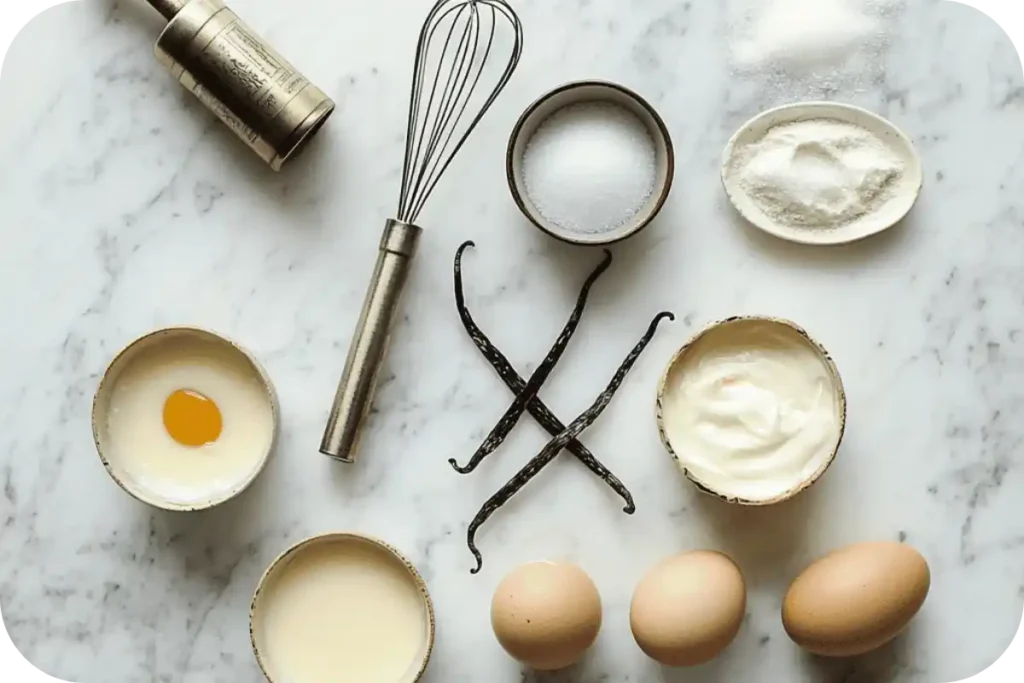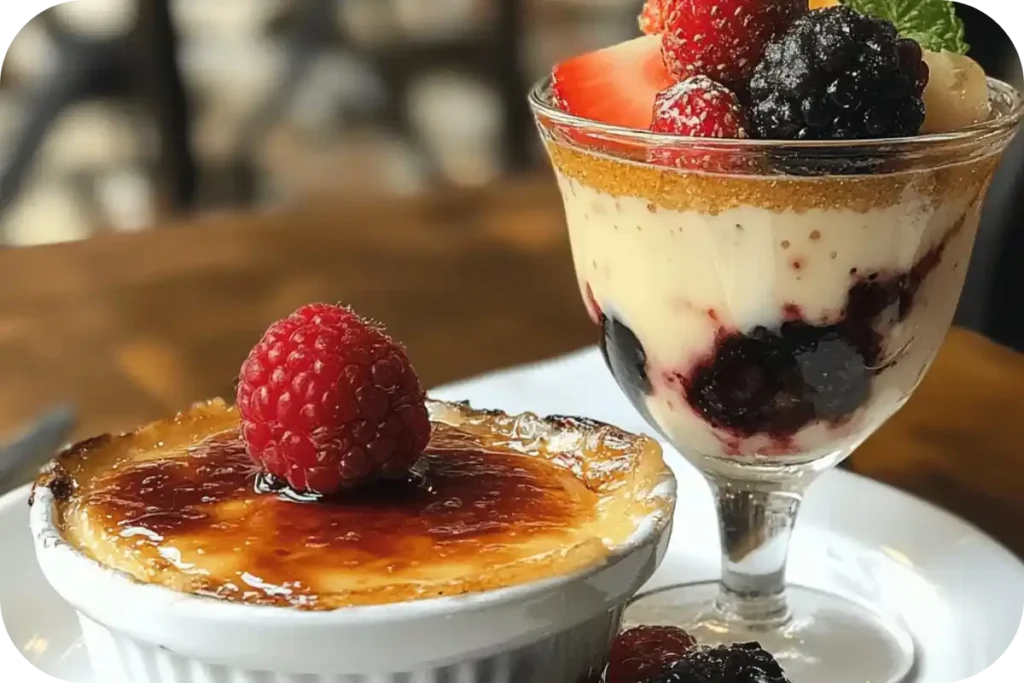If you’ve ever found yourself staring at a dessert menu, wondering “What’s the difference between crème brûlée and custard?”, trust me – you’re not alone. Both are creamy, dreamy, and oh-so-decadent, but they each have their own little twist that makes them special. Whether you’re a dessert lover, a curious foodie, or just someone who loves cracking through that caramelized sugar top (who doesn’t?), we’re breaking it all down for you in the most delicious way possible. Grab a spoon – this is about to get tasty!
Why You’ll Love Knowing This
- Feel Like a Dessert Pro: No more guessing at restaurants – you’ll know exactly what’s on your plate.
- Inspire Your Home Baking: Understanding the differences helps you choose the right dessert for the right mood.
- Boost Your Foodie Cred: Next time someone brings up crème brûlée or custard, you’ll be ready to chime in like a true dessert connoisseur!
Learning about the difference between crème brûlée and custard is like learning the secret handshake to a sweet, creamy club. Let’s get into it!
What Is Custard?
Custard is one of the most comforting, classic desserts out there. At its heart, it’s a mixture of three simple ingredients: milk or cream, egg yolks, and sugar. That’s it. The magic happens when you cook it gently, usually over low heat or in a water bath, until the eggs thicken the mixture into a rich, smooth, spoonable delight.
Custard can be enjoyed in so many ways. It can be poured over fruit, baked into pies, layered into trifles, or simply eaten on its own, warm or chilled. You’ll find custard playing a starring role in everything from banana pudding to Boston cream pie.
And let’s not forget: there are different types of custard too!
- Stirred custards (like crème anglaise) are cooked on the stove.
- Baked custards (like flan or traditional custard tarts) are set in the oven.
It’s versatile, simple, and oh-so-satisfying.

What Is Crème Brûlée?
Crème brûlée takes everything you love about custard – that creamy, silky texture – and gives it a glamorous upgrade. It starts with a rich vanilla custard base, made just like a regular baked custard. But the magic touch comes at the very end: a thin layer of sugar is sprinkled on top, then torched or broiled until it melts and caramelizes into a crispy, golden crust.
The best part? Cracking through that glass-like sugar topping with your spoon and diving into the smooth, cold custard beneath. It’s like a little dessert party in every bite – crunchy, creamy, sweet, and slightly smoky from the caramelization.
Crème brûlée feels a little fancier and is often associated with elegant dinners or special occasions, but honestly, it’s so simple and satisfying, you might find yourself wanting it all the time.

What’s the Difference Between Crème Brûlée and Custard?
Alright, now to answer the big question: what’s the difference between crème brûlée and custard?
In short, all crème brûlées are custards, but not all custards are crème brûlées.
The main difference is in the topping:
- Custard is usually served plain, focusing purely on its creamy texture and subtle flavor.
- Crème brûlée adds a layer of caramelized sugar on top, giving it that iconic crackly finish.
There are a few other little details too:
- Flavor Profile: Crème brûlée tends to have a deeper, slightly burnt sugar flavor from the topping, while plain custard keeps things sweet and mellow.
- Presentation: Crème brûlée is often served in shallow ramekins to maximize the surface area for that sugar topping, while custard can be served in cups, bowls, or dishes of any shape.
- Texture: Both are creamy, but crème brûlée might feel a little firmer underneath that hardened sugar shell compared to some lighter custards.
So next time you’re choosing between the two, it’s all about what you’re craving: pure, smooth comfort or a crunchy-creamy combo!
A Quick Comparison Chart
| Feature | Custard | Crème Brûlée |
|---|---|---|
| Base | Milk/cream, egg yolks, sugar | Same |
| Cooking Method | Baked or stovetop | Always baked |
| Topping | None | Caramelized sugar crust |
| Flavor | Sweet, creamy, mild | Sweet, creamy, with caramelized crunch |
| Texture | Smooth and soft | Smooth underneath a crisp top |
Fun Fact: There Are More Custard Variations!
If you’re really diving into the custard family, you’ll find other relatives too:
- Flan (or crème caramel) – custard with a soft caramel sauce on top.
- Pots de crème – a French dessert that’s like an ultra-rich custard, often flavored with chocolate or coffee.
- Pastry cream – a thick custard used as filling in desserts like éclairs and tarts.
The custard world is big, beautiful, and absolutely worth exploring!
FAQs
Pretty much, yes! Crème brûlée starts with a rich, classic custard base made of cream, egg yolks, and sugar. What makes it special is that final touch – a thin layer of sugar that’s caramelized into a crispy, crackly topping. It’s the perfect combo of creamy and crunchy textures!
Absolutely! If you don’t have a kitchen torch, no worries. You can simply use your oven’s broiler to melt and caramelize the sugar topping. Just keep a close eye on it, because it can go from perfectly golden to burnt super quickly. Trust me, it’s worth it!
Custard is a little simpler because you don’t need to worry about caramelizing sugar. Crème brûlée takes one extra step – that sugar torching or broiling – but it’s still very doable at home. If you’re just starting out, you might want to master a basic custard first, then level up to crème brûlée!
Crème brûlée has a deeper flavor thanks to that caramelized sugar top – a little toasty, a little smoky, and perfectly sweet. The custard underneath stays silky and rich, just like a traditional baked custard. So basically, it’s everything you love about custard, plus a little extra magic.
So, what’s the difference between crème brûlée and custard? It’s all about that sweet, crackly caramelized sugar topping. Both desserts share the same luscious, eggy roots, but crème brûlée steps it up with that show-stopping finish.
Whichever one you choose – plain custard or its fancy cousin, crème brûlée – you’re guaranteed a rich, creamy treat that’ll leave you smiling. Honestly? Why not enjoy both?

